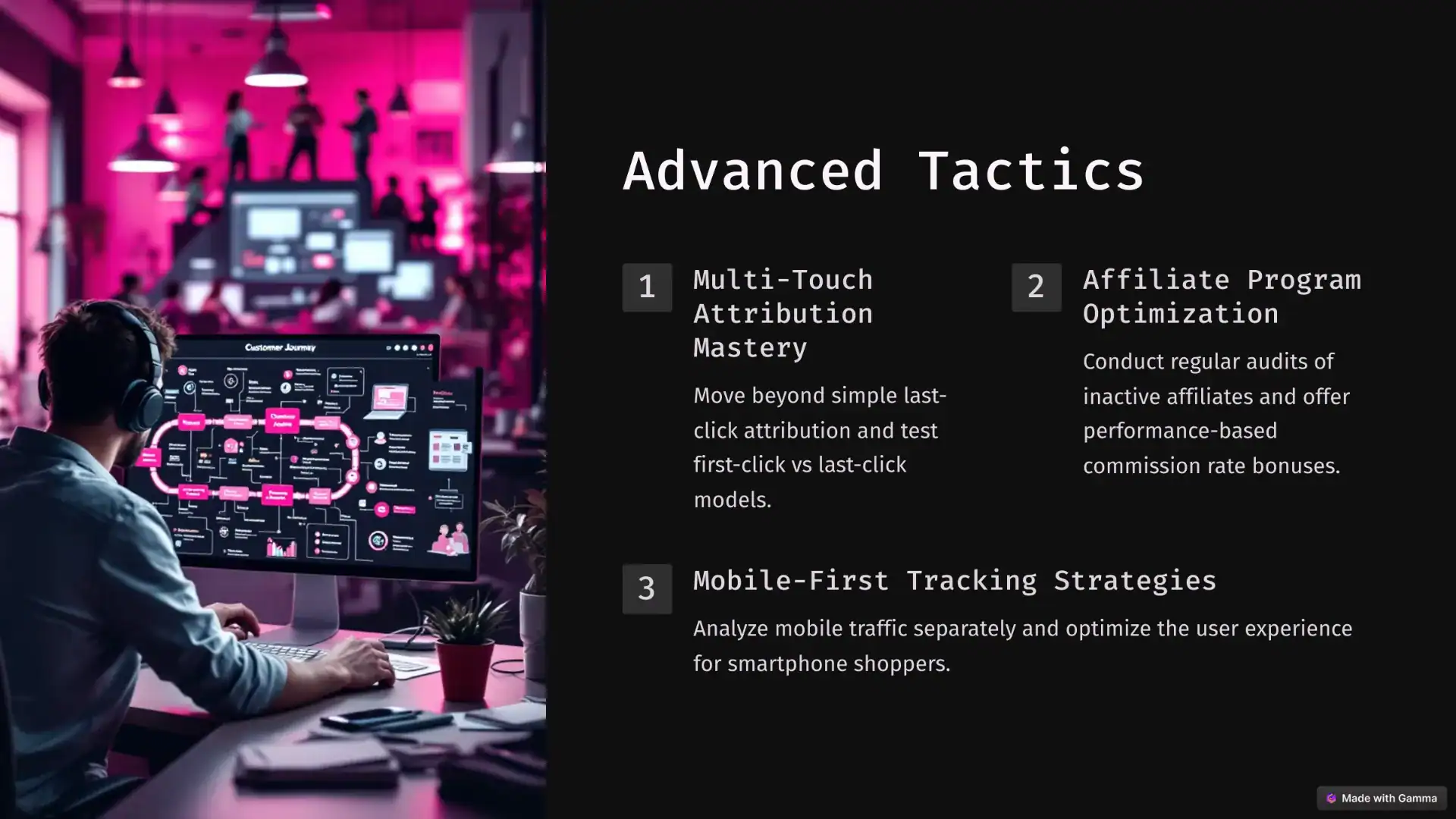Track Affiliate Performance: Beginner’s Guide to Boosting Income
Affiliate marketing is a powerhouse for generating income, but it’s also a numbers game. You can’t just throw links out there and hope for the best.
Tracking affiliate performance is the absolute foundation of success. It’s the difference between stumbling in the dark and confidently walking a well-lit path to profit.
This definitive guide moves beyond the basics, equipping you with the knowledge and strategies to implement sophisticated affiliate link tracking. Whether you’re just starting or looking to refine an established program, you’ll learn how to leverage affiliate marketing analytics to optimize campaigns, maximize profitability, and truly skyrocket your affiliate ROI. We’ll cover everything from foundational pixels to advanced attribution modeling and future-proof techniques.
Who Is This Guide For? (And What You’ll Gain)
-
Digital Beginners (Primary Focus): Get a crystal-clear, step-by-step setup for essential tracking. No jargon, just action. This is foundational to any beginner’s guide to affiliate marketing.
-
Intermediate Marketers: Master UTMs and SubIDs for laser-focused insights.
-
Advanced Strategists: Deepen understanding of attribution, CLV, and future trends.
Key Takeaways:
-
Tracking is Non-Negotiable: Make it your #1 priority. Without data, you’re blind.
-
UTMs & SubIDs are Your Best Friends: Tag relentlessly for granular data.
-
Server-to-Server (S2S) is the Future: Prepare for a cookieless world.
-
Go Beyond Platform Dashboards: Use GA4 (or similar) for true journey analysis.
-
Attribute Wisely: Understand that “last click” often lies.
-
Optimize or Stagnate: Data must fuel testing and improvement.
-
Compliance Builds Trust (and Avoids Fines): Privacy first.
-
Focus on Impact Metrics: ROI, CR, AOV, CLV matter more than raw clicks.
-
Adapt or Die: Stay ahead of tech shifts (AI, cookieless).
-
Data-Driven Decisions ONLY: Let insights, not gut feelings, guide you.
Step 1: Goal Setting – The “Why” Behind Your Tracking

Stop. Before you track a single click, define your success. Are you aiming for a $500/month side hustle or a $5,000/month career shift? Knowing your endpoint makes tracking affiliate performance a map, not a maze. This clarity is vital when you create an affiliate marketing strategy.
Why “More Money” is a Useless Goal (And What to Do Instead)
“More money” is a wish, not a target. Effective tracking demands SMART goals:
-
S – Specific: Not “more sales.” Instead: “Generate 10 sales for Product X in Month 1.”
-
M – Measurable: If you can’t measure it, you can’t improve it. Tracking provides this.
-
A – Achievable: $10k in Month 1? Unlikely. Instead: “Increase affiliate clicks by 20% in 30 days.”
-
R – Relevant: Does this align with your niche and audience needs?
-
T – Time-bound: Not “eventually.” Instead: “Earn first $100 commission within 60 days.”
Expert Analysis: The Cost of Skipping Goals
Most beginners skip this. They chase shiny objects. Result? Wasted effort, burnout. Specific goals (e.g., “Achieve $1 EPC on my top product in 3 months”) turn tracking from a chore into a powerful diagnostic tool. It tells you what’s working and what’s bleeding your time.
Actionable Task for Digital Beginners (Do This NOW):
-
Open a document. Answer:
-
Realistic weekly time commitment for affiliate marketing?
-
Income target: 3 months? 6 months? 1 year?
-
One specific action this week towards those targets? (e.g., “Write one review post for X product,” “Share my link on Y platform.”)
-
Clarity on these points transforms numbers into progress indicators for your dream.
Step 2: Understanding Key Affiliate Metrics – What Actually Matters
Don’t drown in data. Focus on these vital signs.
The Absolute Essentials:
-
Conversion Rate (CR): % of visitors who take your desired action (buy, sign up). This is your efficiency score.
-
Click-Through Rate (CTR): % of people who see your link and click it. Measures how compelling your call-to-action is.
-
Bounce Rate: % of visitors who land and leave without interacting. High bounce = something’s wrong. Improving this means learning to reduce bounce rate effectively.
-
Average Session Duration: How long people stay. Longer can be better.
-
Pages per Session: How many pages they visit. Indicates engagement.
Step 3: Decoding Your Affiliate Dashboard – Finding Your Key Metrics (Beginner’s Guide)
Affiliate dashboards can look intimidating. They aren’t. Here’s where to find core metrics:
1. Clicks: Your Traffic Lifeline
-
What It Is: Total clicks on your unique affiliate links.
-
Where to Find It: Usually labeled “Clicks,” “Link Activity,” or similar on your main dashboard/reports. (Note: “Impressions” count views, not clicks. Understand what impressions are in advertising to distinguish.)
-
Critical Question for Beginners: Are my promotion efforts even being seen? Low clicks = visibility problem.
2. Conversions (Sales/Leads): The “Money” Metric
-
What It Is: Clicks that resulted in a desired action (sale, lead). This is your conversion tracking at work.
-
Where to Find It: Near “Clicks.” Look for “Conversions,” “Sales,” “Leads,” “Actions.”
-
Critical Question for Beginners: Are my clicks turning into results? This is your direct link to income.
3. Conversion Rate (CR): Your Efficiency Score
-
What It Is: (Conversions / Clicks) * 100.
-
Where to Find It: Some dashboards auto-calculate. If not, it’s simple math.
-
Example: 10 sales / 500 clicks * 100 = 2% CR.
-
-
Critical Question for Beginners: Is my audience a good match for the offer, and is my message effective? Low CR indicates a mismatch or weak persuasion.
4. Commissions (Earnings): Your Actual Take-Home
-
What It Is: The money you’ve earned.
-
Where to Find It: Labeled “Commissions,” “Earnings,” “Payout.”
-
Critical Question for Beginners: Is the time I’m investing paying off in real dollars? This is your direct ROI.
5. Earnings Per Click (EPC): Quick Profitability Check
-
What It Is: (Total Commissions / Total Clicks).
-
Where to Find It: Some dashboards show it; otherwise, calculate.
-
Example: $50 commissions / 500 clicks = $0.10 EPC.
-
-
Critical Question for Beginners: Which links/promotions are most profitable per click? Helps compare efforts.
Beginner Focus: Simplify!
Start with Clicks, Conversions, Commissions. Master these. Then explore deeper. Most platforms have built-in ‘analytics tools’; get curious.
Actionable Step: Log into an affiliate dashboard. Find Clicks, Conversions, Commissions. Screenshot it. Build this ‘affiliate program analysis’ habit.
Step 4: Leveraging Analytics Platforms (Google Analytics is Your Friend)
Your affiliate platform dashboard is a start. Google Analytics 4 (GA4) provides far deeper insights.
Google Analytics 4 (GA4): The Powerhouse
-
Traffic Sources: Exactly where visitors originate (organic, social, referral).
-
User Behavior: What they do on your site. Engagement, bounce, flow.
-
Conversions: Track actions beyond just sales (e.g., newsletter sign-ups if that’s a goal).
-
Audience Segmentation: Understand who your visitors are.
-
Customer Journey Mapping: See the entire path to conversion.
GA4 offers powerful reports, but its true strength lies in customizing it to your needs.
Other Analytics Players:
-
Adobe Analytics: Enterprise-level, powerful.
-
Matomo: Privacy-focused open-source alternative.
-
Platform-Specific (e.g., Facebook Insights): Useful for channel-specific data.
Step 5: Why Precision Tracking is Non-Negotiable
Accurate tracking is the central nervous system of your affiliate business. Vague data leads to vague results.
-
True ROI Calculation: Know exactly which efforts drive profit, not just clicks.
-
Actionable Optimization: Data pinpoints weaknesses. Fix what’s broken, scale what works.
-
Reward Top Partners: Identify and nurture high-value affiliates (quality over quantity).
-
Fraud Detection: Anomalies in data (e.g., high clicks, zero sales) signal problems.
-
Strategic Decisions: Let data guide content, offers, and overall marketing. This includes mastering SEO best practices for your affiliate content.
-
Understand Full Customer Journeys: See how affiliate marketing interacts with other channels.
Step 6: Building Your Core Tracking Foundation
Ensure these are flawless before moving to advanced tactics.
A. Standard Affiliate Links & Basic Cookies
-
How it works: Unique URLs per partner. A click drops a cookie (text file) on the user’s browser with affiliate/campaign ID. A later conversion reads this cookie for attribution.
-
Critical Point: Cookie duration and policies vary. Understand them.
B. Conversion Tracking Pixels (The Confirmation)
-
How it works: A tiny code snippet (image or JavaScript) on your “Thank You” or confirmation page. When it loads for a user with an affiliate cookie, it “fires,” telling the platform a conversion happened and who gets credit.
-
Critical Point: Ensure pixels are correctly implemented and fire reliably. Test them!
Step 7: UTM Tracking – Pinpoint Your Success (No More Guesswork!)
Stop wondering which blog post, email, or social share drove that sale. UTM parameters tag your links to tell you exactly where clicks and sales originate. This is fundamental for ‘tracking affiliate links.’
What are UTM Parameters? (Simple Explanation)
Short text snippets added to your link’s end. They don’t change the destination, only the data Google Analytics (and other tools) receive.
Key UTMs for Beginners:
-
utm_source: Who sent the traffic? (e.g., facebook, active_campaign_newsletter, guest_post_on_xyzblog)
-
utm_medium: What type of link was it? (e.g., social_cpc, email, banner_ad, organic_link_in_article)
-
utm_campaign: Which specific promotion is this? (e.g., spring_sale_2024, ebook_launch_product_A)
Example:
-
Base Affiliate Link: https://product.com/yourid
-
UTM-Tagged Link (for a Facebook post about a spring sale):
https://product.com/yourid?utm_source=facebook&utm_medium=social_organic&utm_campaign=spring_sale_2024
How to Create UTM Links (The Easy Way – No Memorization Needed!)
-
Google “Campaign URL Builder.” Use Google’s free tool.
-
Paste your base affiliate link into “Website URL.”
-
Fill in utm_source, utm_medium, utm_campaign. Be descriptive and consistent!
-
Copy the generated URL.
-
Use this tagged link in your specific promotion.
Where to See UTM Data:
In Google Analytics: Acquisition > Campaigns > All Campaigns. You’ll see performance by source, medium, and campaign. This is ‘data-driven marketing’ 101.
Expert Analysis: The Hidden Cost of NOT Using UTMs
Not using UTMs is like throwing marketing money into a black hole. You can’t tell what worked, so you can’t replicate success or cut losses. Every click you don’t tag with UTMs is a missed learning opportunity and potentially wasted effort. Effective A/B testing, for example, to increase your affiliate marketing conversion rate, becomes impossible without this granularity.
Contrarian Viewpoint (For Overwhelmed Beginners):
Don’t aim for UTM perfection from day one. Start with source, medium, and campaign for your main promotional channels. Consistency with a few tags beats sporadic use of many. Get comfortable, then expand.
Actionable Task: Create one UTM-tagged affiliate link NOW for an upcoming promotion. Note where you’ll use it. Check its performance later.
Step 8: Advanced Tracking Techniques (For When You’re Ready)
Once UTMs are second nature, explore these:
A. Deeper Dive into UTM Parameters
-
utm_content: Differentiate ads/links pointing to the same URL within one campaign (e.g., blue_banner_sidebar vs. red_banner_footer). Essential for A/B testing creatives.
-
utm_term: Typically for paid search keywords. Can be repurposed for other specific tracking.
-
UTM Consistency is CRITICAL: Develop a strict naming convention (e.g., all lowercase, use underscores instead of spaces). Facebook and facebook will report as two different sources. Messy UTMs = useless data.
B. SubIDs: Affiliate-Side Granularity
-
What they are: Parameters affiliates can add to their links (e.g., aff_link?subid=blog_review_page&subid2=cta_button_bottom).
-
Benefit: Allows affiliates to track which of their specific placements generated the conversion. Encourage and support this.
C. Server-To-Server (S2S) Tracking: The Future Standard
-
Problem it solves: Browsers are increasingly blocking third-party cookies (what pixels rely on).
-
How it works: Your server communicates directly with the affiliate platform’s server when a conversion happens, using a unique click ID. No browser pixel needed.
-
Why it’s vital: More accurate, reliable, and privacy-respecting. Technically more complex but essential long-term.
D. Coupon Code Tracking
-
How it works: Assign unique, trackable coupon codes to affiliates/campaigns. Attribute sales at checkout even if click tracking fails.
-
Requires: Integration between e-commerce and tracking systems.
E. Phone Call Tracking
-
For businesses where calls = conversions: Use dedicated call tracking (unique numbers per affiliate/campaign). Tracks source, duration, etc.
Step 9: Shielding Against Fraud – A Proactive Playbook
Affiliate fraud (bot clicks, cookie stuffing, fake leads) can drain profits. Be vigilant. Understanding common affiliate marketing mistakes includes recognizing fraud risks.
| Threat Type | Primary Solution | Example Tools |
| Bot Clicks | IP filtering, behavior analysis | ClickCease, Voluum |
| Cookie Stuffing | Conversion validation, audit trails | Trackonomics |
| Fake Leads/Sales | Email verification, pattern checks | ZeroBounce, Sift |
Critical Action: Regularly audit your performance reports for suspicious patterns. Don’t “set and forget.”
Step 10: Seasonal Strategy – Tracking for Peak Events (e.g., Black Friday)
High-traffic events demand peak tracking performance:
-
Real-Time Dashboards: Monitor results as they happen.
-
Incentivize Wisely: If offering temporary commission bumps, track their direct impact.
-
Hourly Click Monitoring: Identify sudden spikes or drops to react fast.
Step 11: Choosing Your Arsenal – Platforms & Analytics
Select tools that fit your needs and scale with you. Explore comprehensive lists of affiliate marketing tools to understand your options.
-
Affiliate Marketing Platforms (e.g., Impact, PartnerStack, ShareASale): Manage partners, links, core tracking, reporting, payments.
-
Critical Evaluation Points: Tracking reliability, support, pricing, feature set.
-
-
Web & Marketing Analytics (e.g., Google Analytics 4, Matomo): Essential for full user journey analysis. Integrate UTM data to see on-site behavior.
-
Business Intelligence (BI) Tools (e.g., Tableau, Power BI): For advanced users. Merge affiliate data with CRM, sales data for holistic views (e.g., true CLV).
Step 12: Decoding Performance – Key Metrics & Attribution Models
Track the right numbers and understand how credit is assigned.
Essential Performance Metrics (KPIs) – Beyond the Basics:
-
Earnings Per Click (EPC): (Total Commissions / Total Clicks). Your per-click profitability.
-
Return on Investment (ROI) / Return on Ad Spend (ROAS): (Revenue – Costs) / Costs. The ultimate profitability proof.
-
Average Order Value (AOV): Average purchase value from affiliate referrals. Crucial for high-ticket affiliate marketing.
-
Customer Lifetime Value (CLV): Predicted total profit from a customer acquired via affiliates. Hard to track accurately but gold for identifying quality partners.
-
Affiliate Contribution: % of total sales/leads from the affiliate channel.
-
New vs. Returning Customers: Are affiliates driving new business?
Understanding Attribution Models – Who Gets Credit?
Attribution assigns credit when users interact with multiple touchpoints before converting. Your choice impacts how you value channels.
| Model | How Credit is Given | When to Consider |
| Last Click | 100% to the final touchpoint. | Simple, but often misleading. Good for direct response. |
| First Click | 100% to the initial touchpoint. | Highlights awareness drivers. |
| Linear | Equal credit to all touchpoints. | When all touchpoints are considered equally important. |
| Time Decay | More credit to touchpoints closer to conversion. | If recent interactions are more influential. |
| Position-Based | Credits first & last most (e.g., 40% each), rest to middle. | Balances awareness and closing. |
| Data-Driven | Uses ML to assign credit based on your data’s impact. | Ideal, but needs sufficient data volume (GA4 has it). |
Critical Thinking on Attribution:
Last-click is the default for many platforms, but it’s often a lie. It ignores all the earlier touchpoints that influenced the buyer. If possible, use GA4 to compare models. Understand how different models would change your perception of which affiliates are most valuable.
Step 13: From Data To Dollars – Optimization Fueled By Tracking
Data is useless without action. This is where you turn insights into income.
The “Review, Hypothesize, Tweak, Measure” Optimization Loop (For Beginners)
-
Review (Weekly/Bi-Weekly):
-
Look At: Key metrics (Clicks, CR, EPC, Earnings) per campaign/source.
-
Ask: “What over/underperformed? Why?”
-
Common Pitfall: Only looking at earnings. Low earnings might hide a high CR on a low-traffic source – an opportunity!
-
-
Hypothesize (Educated Guess “Why?”):
-
Example: “Blog post X got high clicks but low CR. Hypothesis: The call-to-action is weak or the audience match is poor for this specific offer.”
-
Pro Tip: Formulate hypotheses as testable statements.
-
-
Tweak (Make ONE Small, Isolated Change):
-
Don’t change multiple things at once! You won’t know what caused the impact.
-
Example (from above): “I will change only the call-to-action button text on Blog post X.”
-
Common Pitfall: Impatience leading to too many simultaneous changes.
-
-
Measure (Track the Impact of Your Tweak):
-
Give it enough time for new data. Compare to the pre-tweak period.
-
Example: “After changing CTA, CR on Blog post X increased from 0.5% to 1%.”
-
Pro Tip: Document your changes and results meticulously.
-
-
Repeat & Refine: Optimization is continuous. Some tweaks win, some lose. Learn from both. This iterative process can be enhanced by understanding the keys to creating successful content on your blog.
Expert Analysis: The Compounding Power of Small Wins
Beginners chase “hacks.” Pros focus on consistent, incremental improvements. A 1% improvement here, a 2% there – it compounds. This loop, done diligently, is the “hack.”
Beginner Pitfall: “Analysis Paralysis”
Don’t get so lost in data you forget to act. A simple review + one tweak per week beats hours of chart-staring. Action creates more data.
Advanced Optimization Tactics:
-
Strategic A/B Testing: Rigorously test ONE variable (landing page, creative, offer) using utm_content or dedicated A/B testing tools. Aim for statistical significance. Consider how you might create a landing page for affiliate marketing that is easily testable.
-
Landing Page Optimization (LPO): Use heatmaps (e.g., Hotjar) and GA4 to analyze affiliate traffic behavior on-page. Improve relevance, clarity, CTAs.
-
Affiliate Segmentation: Group affiliates (top, mid, new; content, coupon, influencer). Tailor communication, resources, and even commission structures.
-
Commission Structure Optimization: Test performance tiers, bonuses for AOV, or different rates for new vs. returning customers – all based on data.
-
Prune Underperformers: If consistent low quality/zero conversions despite support, cut them. Focus resources on winners.
Step 14: Navigating Compliance, Privacy & Trust
Ignoring privacy (GDPR, CCPA, etc.) is a costly mistake. Trust is paramount.
-
Know Key Regulations: Understand rules in your operating regions (consent for cookies, transparency, data security, user rights).
-
Compliant Cookie Banners/CMPs: Essential for lawful consent.
-
Clear Privacy Policy: Explain your tracking practices.
-
Affiliate Agreements: Mandate affiliate compliance with laws (including disclosure).
-
Transparency with Affiliates: Be clear on your tracking/attribution.
Step 15: Future-Proofing Your Tracking – Trends to Watch
The landscape is always shifting. Stay informed by following top affiliate marketing trends.
-
The Cookieless World: S2S tracking, first-party data, contextual targeting are no longer optional.
-
AI & Machine Learning: Expect AI in fraud detection, attribution, optimization, and personalization. AI can also help you generate content for affiliate marketing.
-
Cross-Platform/Device Tracking: Unified IDs and graph-based solutions aim for holistic user views.
-
Incrementality Measurement: Proving affiliate sales are truly additional (not cannibalized) will grow in importance.
-
Deeper API Integrations: Seamless data flow between platforms (affiliate, CRM, analytics, BI) for richer insights.
Real-World Impact: Case Study Snippets
- UTM Discovery: A company using consistent UTMs discovered a niche blogger (low traffic volume) drove significantly higher AOV and CLV than a major coupon site (high volume, low margin sales). They shifted promotional focus and budget, dramatically increasing overall profitability.
- Attribution Shift: By switching from last-click to a position-based model in GA, a SaaS business realized several content affiliates, previously undervalued, played a crucial role early in the customer journey. They re-engaged these partners, leading to higher quality lead generation.
- A/B Test Win: Testing two banner creatives using utm_content revealed that a simpler design with a clearer call-to-action had a 30% higher CTR and 15% higher conversion rate, providing clear direction for future creative development. This embodies the power of a growth mindset applied to marketing.
The Road Ahead: Future Trends in Affiliate Tracking
Stay ahead of the curve:
- The Cookieless Shift: Third-party cookies are fading. Master Server-to-Server (S2S) tracking, leverage first-party data strategies, explore contextual targeting, and utilize platform-specific IDs.
- AI & Machine Learning: AI will increasingly power fraud detection, predictive attribution modeling, campaign optimization suggestions, and personalization in affiliate marketing.
- Cross-Platform & Cross-Device Tracking: Solutions like Unified IDs and graph-based tracking aim to provide a more complete view of user journeys across their multiple devices.
- Measuring Incrementality: Proving that affiliate sales are truly additional revenue, not just capturing sales that would have happened anyway, will become more critical. This involves sophisticated testing like geo-lift studies. Adopting new methods is key to unlocking your best life in the evolving digital landscape.
API Integrations: Deeper integrations between affiliate platforms, CRMs, analytics, and BI tools will enable more seamless and powerful data analysis. This constant learning process fuels mental evolution.
References:
- Google Analytics Help – Collect Campaign Data with Custom URLs: https://support.google.com/analytics/answer/1033863?hl=en (Official Google guide to UTM parameters)
- Impact.com – Server-to-Server (S2S) Tracking Explained: https://impact.com/partners/server-to-server-s2s-tracking-explained/ (Clear explanation of S2S concepts from a major platform)
- HubSpot Blog – The Ultimate Guide to Affiliate Marketing: https://blog.hubspot.com/marketing/affiliate-marketing-guide (Excellent general overview of affiliate marketing concepts)
- IAB – Measurement & Attribution: https://www.iab.com/topics/measurement-attribution/ (Industry body resources on measurement standards)
- Performance Marketing Association – Compliance Resources: https://thepma.org/compliance/ (Resources related to legal and ethical standards in performance marketing)
- Google Analytics Help – About Data-Driven Attribution: https://support.google.com/analytics/answer/10596866?hl=en (Understanding GA4’s advanced attribution model)
- MarTech – Affiliate Marketing Guides & News: https://martech.org/topic/affiliate-marketing/ (Stay updated on industry trends and technology)
- GDPR Official Website (EU): https://gdpr-info.eu/ (Full text and official guidance on GDPR)
- California Consumer Privacy Act (CCPA) Info: https://oag.ca.gov/privacy/ccpa (Official information on California’s privacy law)
- Affiliate Summit Blog: https://www.affiliatesummit.com/blog (Insights and articles from a leading industry conference series)
I’m Alexios Papaioannou, an experienced affiliate marketer and content creator. With a decade of expertise, I excel in crafting engaging blog posts to boost your brand. My love for running fuels my creativity. Let’s create exceptional content together!











